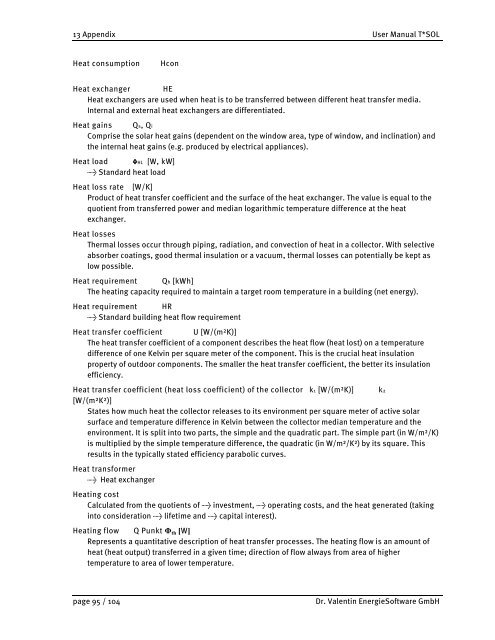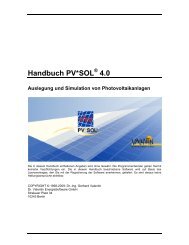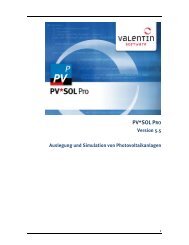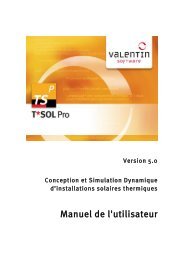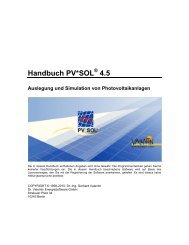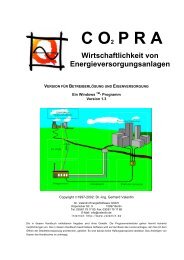Manual T*SOL basic 5.0 - Valentin Software
Manual T*SOL basic 5.0 - Valentin Software
Manual T*SOL basic 5.0 - Valentin Software
Create successful ePaper yourself
Turn your PDF publications into a flip-book with our unique Google optimized e-Paper software.
13 Appendix User <strong>Manual</strong> <strong>T*SOL</strong><br />
Heat consumption Hcon<br />
Heat exchanger HE<br />
Heat exchangers are used when heat is to be transferred between different heat transfer media.<br />
Internal and external heat exchangers are differentiated.<br />
Heat gains Qs, Qi<br />
Comprise the solar heat gains (dependent on the window area, type of window, and inclination) and<br />
the internal heat gains (e.g. produced by electrical appliances).<br />
Heat load ΦHL [W, kW]<br />
→ Standard heat load<br />
Heat loss rate [W/K]<br />
Product of heat transfer coefficient and the surface of the heat exchanger. The value is equal to the<br />
quotient from transferred power and median logarithmic temperature difference at the heat<br />
exchanger.<br />
Heat losses<br />
Thermal losses occur through piping, radiation, and convection of heat in a collector. With selective<br />
absorber coatings, good thermal insulation or a vacuum, thermal losses can potentially be kept as<br />
low possible.<br />
Heat requirement Qh [kWh]<br />
The heating capacity required to maintain a target room temperature in a building (net energy).<br />
Heat requirement HR<br />
→ Standard building heat flow requirement<br />
Heat transfer coefficient U [W/(m²K)]<br />
The heat transfer coefficient of a component describes the heat flow (heat lost) on a temperature<br />
difference of one Kelvin per square meter of the component. This is the crucial heat insulation<br />
property of outdoor components. The smaller the heat transfer coefficient, the better its insulation<br />
efficiency.<br />
Heat transfer coefficient (heat loss coefficient) of the collector k1 [W/(m²K)] k2<br />
[W/(m²K²)]<br />
States how much heat the collector releases to its environment per square meter of active solar<br />
surface and temperature difference in Kelvin between the collector median temperature and the<br />
environment. It is split into two parts, the simple and the quadratic part. The simple part (in W/m²/K)<br />
is multiplied by the simple temperature difference, the quadratic (in W/m²/K²) by its square. This<br />
results in the typically stated efficiency parabolic curves.<br />
Heat transformer<br />
→ Heat exchanger<br />
Heating cost<br />
Calculated from the quotients of → investment, → operating costs, and the heat generated (taking<br />
into consideration → lifetime and → capital interest).<br />
Heating flow Q Punkt Φth [W]<br />
Represents a quantitative description of heat transfer processes. The heating flow is an amount of<br />
heat (heat output) transferred in a given time; direction of flow always from area of higher<br />
temperature to area of lower temperature.<br />
page 95 / 104 Dr. <strong>Valentin</strong> Energie<strong>Software</strong> GmbH


